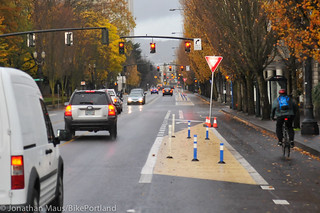Local academics hit the curbs of the Lloyd District Friday to gather data that’ll examine Portlanders’ attitudes toward the neighborhood’s newest protected bike lane.
Separated from autos by a wide strip of beeswax yellow paint, a few parking spots, some plastic bollards and a set of concrete planters, Multnomah Street’s protected bikeway was the signature bike project from former Sam Adams staffer Tom Miller’s brief stint running the Portland Bureau of Transportation. It’s now part of a six-city study of how protected bike lanes are working.
The study’s leaders are Chris Monsere, Jennifer Dill, Kelly Clifton and Nathan McNeil, all of Portland State University. At the Oregon Transportation Summit last month, Monsere and Dill presented results from San Francisco, Austin and Washington DC suggesting that the protected bike lanes studied tend to be better-liked than unprotected ones among people using both cars and bikes. But they also found that the lanes didn’t lead to immediate spikes in the number of people biking on the street.
The study is happening even as the Federal Highway Administration prepares to gather information assessing whether the new designs are safe enough for a full-throated federal endorsement. With this data emerging at almost the same time, these results are likely to be closely watched by whichever professionals end up preparing the federal study.
The research is funded by PeopleForBikes’ Green Lane Project (full disclosure: my other gig; but we cover them only at Jonathan’s request) and by the Oregon Transportation Research and Education Consortium.
Separation like Multnomah’s is modeled after similar designs in use around the world and increasingly common in U.S. cities. (Canadian ones, too — the first North American city to use them widely was Montreal.)
Before installing it last year, the City of Portland described Northeast Multnomah’s design as a low-budget draft of what the street would eventually look like. With one of the city’s biggest apartment projects ever going up on this street (and offering fewer residential auto parking spaces than it’ll offer apartments) we’ll be interested to see what further changes might be in store.


